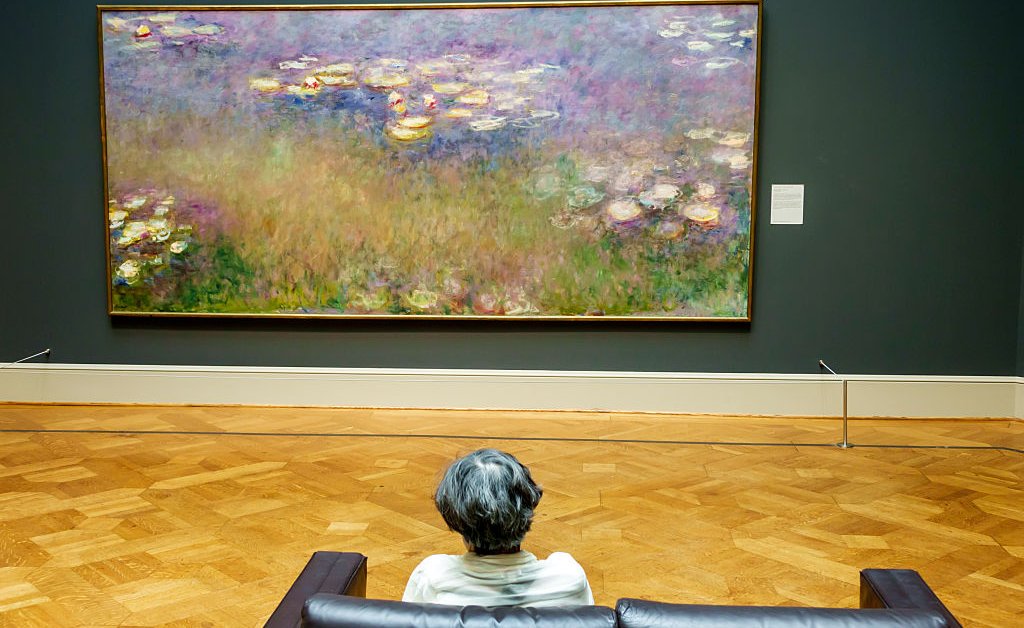
When I was a little girl, my mother had an umbrella that I wasn’t allowed to use. It was a stick umbrella, the expensive kind with a wooden handle, and the top panels were printed with a watery, vague image—green splotches, purple streaks, blue swirls. This was my first introduction to French Impressionist painter Claude Monet, through a museum-branded household object, and for a long time, that’s all I cared to know of the artist. As far as I was concerned, his work was for suburban mothers and other middle-brow shoppers. Even after I had been exposed to his paintings in high school during a school field trip to the Museum of Fine Art in Boston, I continued to associate the Impressionists with mass-produced souvenirs. I had started studying art history and theory somewhat seriously, and Monet was not for serious people. Compared to contemporary art, which was thrillingly opaque, and ancient art, which was fascinatingly distant, these pretty paintings were boring. I didn’t understand what was so revolutionary about abstraction, and I certainly had no idea that Monet’s soft blooms were a direct response to the unprecedented horror of World War I.
I can’t pretend I know exactly what Claude Monet was thinking as he stood at his outdoor easel in Giverny during the summer of 1914. Thousands of French soldiers had already died in the trenches of World War I, and conflict was coming ever closer to the artist. “I shall stay here regardless,” he wrote from his beloved country home, located just 30 miles from the battlefield, “and if those barbarians wish to kill me, I shall die among my canvases, in front of my life’s work.” It was against this backdrop that Monet created his most famous works: a series of horizonless canvases dappled with shadows, lit from above, strewn with blooming water lilies. Like so many before him, Monet honored the slaughtered with flowers. It’s a practice that spans cultures, from the marigolds of Día de los Muertos to the poppies of Remembrance Day. The association between beautiful, generative plants and destructive, uniquely human behavior has been so repeatedly solidified that at times, it can seem innate. Yet it’s something we chose to do—to tie the worst of ourselves to some of the best and brightest things in the natural world. Beauty and violence exist in tandem because we will it so.
When faced with encroaching chaos, in the seventh decade of his life, grieving the deaths of several family members and the slow degradation of his eyesight, Monet chose to look down into the waters of his pleasure pond and paint. He had created this body of water two decades before by diverting a stream into his patch of country marshland and importing exotic blossoms from abroad. His obsession with lotuses and lilies scandalized the locals (who feared the aquatic plants would take over the waterways) but the pond pleased the painter to no end. It was his refuge, the wide world writ small and manageable. “If William Blake saw the world in a grain of sand,” wrote art historian Ross King in Mad Enchantment: Claude Monet and the Painting of the Waterlilies, “Monet could glimpse, in the mirrored surface of his lily pond, the dazzling variety and abundance of nature.” Although the painter admitted to being “embarrassed” by his continued commitment to art during wartime, he felt there was a value in attempting to capture the beauty of his environment. Not only was the act of painting a defiance of the ravages of war, Monet also chose to donate his canvases to the nation—on the condition that the government find a suitable way to display them. The French rose to the occasion, designating an entire gallery in the Musee Orangerie to the painter’s vision.
I have yet to visit this faraway room but I have friends who have spent time there. Some say it was transcendent, while others say it was too busy, too touristy, too familiar. I still want to go, especially now that I know the context of their creation. The ugly truth is that I, like many people, value beauty more dearly when it is set against the backdrop of suffering. Pain validates prettiness, adding an illusion of depth to something that is, on a surface level, attractive enough already. Violence, unlike flowers, was something I’ve always understood to be important, compelling, and worthy of somber consideration. I’m an American and for us, violence is often depicted as a valid form of self-expression. Bloodshed can be edgy or envelope-pushing. According to our filmmakers, it can even be beautiful. “It’s just another color to work with,” Quentin Tarantino once famously said. “It doesn’t mean anything.”
Read more: Why We Love Violent Delights
Except, of course, that second part is not true. Violence in art means something just as bloodshed in life means something. Aesthetics matter, and aestheticizing violence is one way of spinning it into myth, elevating brutal actions to an almost spiritual level. Like beauty, violence can appear transcendent. It can shift one’s reality, alter one’s brain chemistry and even change one’s gene expression. There is a power to it, one that flowers sorely lack.
And yet, we’ve wound these things together, blood and roses. Flowers are a janus symbol, their pretty faces mean both life and death. Wilting flowers in a vase can serve as an artists’ memento mori while fresh flowers in a wreath signify the quickening of new life and the fruits of spring. Even without the war, Monet’s series of immersive, challenging, almost psychedelic canvases, dappled with sacred lotus flowers (a symbol of transcendence, beauty rising from the muck) should matter greatly. Their existence should be enough.
But I’m a rubbernecker; I stare at the crosses by the side of the road, decorated with plastic flowers, scenes from a recent death, and I wonder: Whose life ended on this stretch of highway? I see the fresh flowers in a cemetery and I can’t help but look at the dates. Who died, how young? The truth is that I’m seduced by what sickens me. Even now, I catch myself dismissing the calm, the good, the nice in favor of the poignant, the strange, the intense. Life is full of small, familiar pleasures, yet I still underrate them in favor of those big swoops of drama. I don’t like this about myself.
Lately, I’ve been trying to rewire my brain slightly—to think more like Monet. His wisdom was hard-won, late-in-life. But after living through a pandemic, I feel that I’ve gained some perspective. In the past few years, I’ve attended too many funerals. I’ve become wary of the scent of white lilies. I’ve also had to race to daycare to pick up my daughter after a violent threat was made, images of bloodshed roaring through my head. There was nothing transcendent about those mad minutes, nothing beautiful about the sour smell that emitted from my body for hours afterwards, nothing to be gleaned from the sheer intensity of emotion or the grasping desperation of fear. If there were flowers around that morning, I was unable to see them, much less appreciate their colors.
I could dwell in those places, for they have power and weight, not to mention a healthy population of prisoners. Instead, I’m trying to honor the small plants that come across my path, the fuchsia bursts of fringed polygala, the spotted yellow of a trout lily. I’m not much of a painter, but I can bestow my attention on the things that grow around and in front of me. Their meaning is no more or less than life itself.
More Must-Reads From TIME














